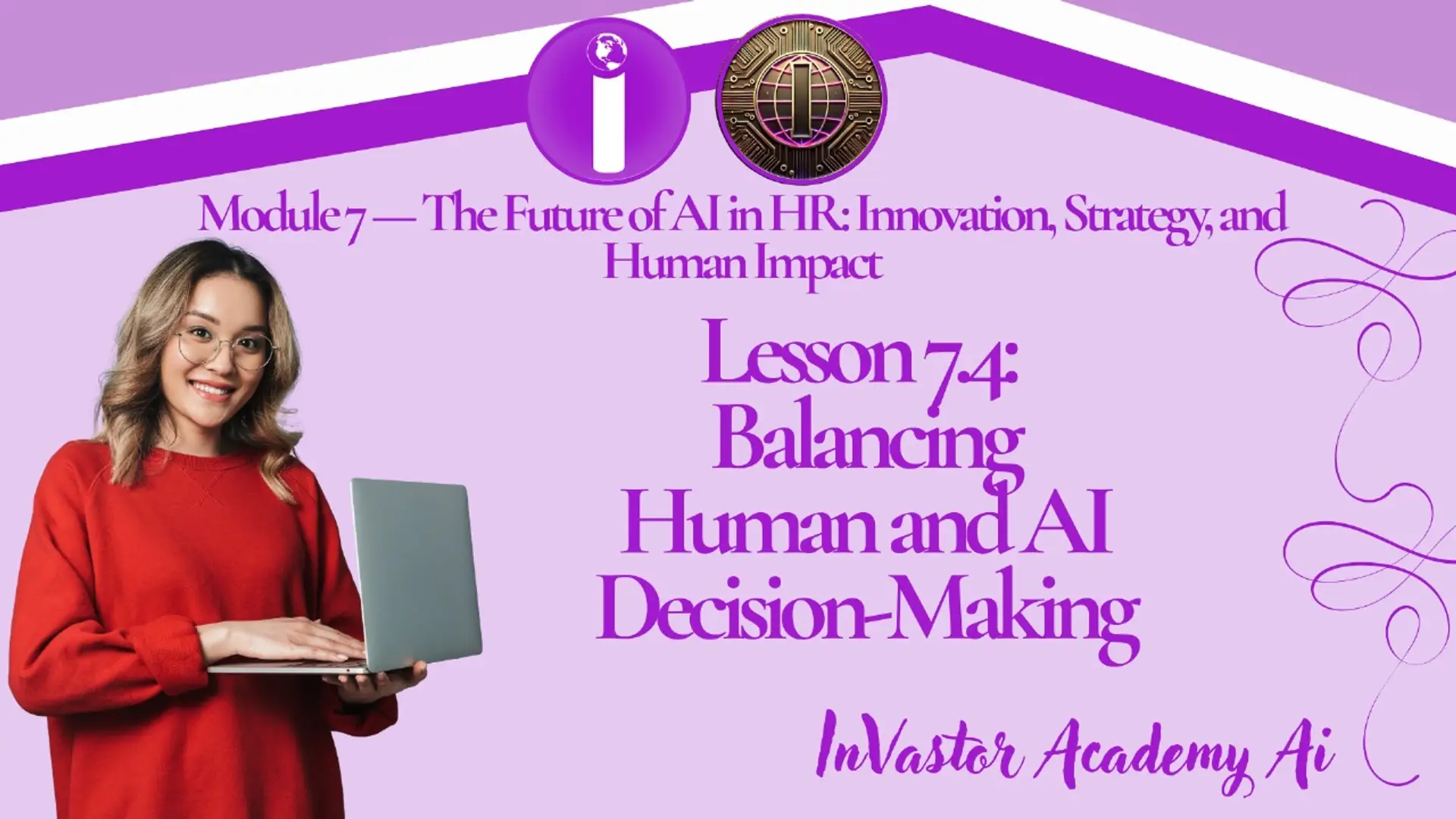

Lesson 7.4 — Balancing Human and AI Decision-Making
Module 7 — The Future of AI in HR: Innovation, Strategy, and Human Impact
Lesson 7.4 — Balancing Human and AI Decision-Making
Learning Objectives
By the end of this lesson, learners will be able to:
- Understand the importance of integrating human judgment with AI insights in HR decision-making.
- Identify HR processes where human oversight is critical.
- Evaluate the risks of over-reliance on AI and the limitations of automated decision-making.
- Design strategies that combine AI efficiency with human empathy, ethics, and contextual understanding.
- Apply best practices for responsible and effective AI-human collaboration in HR.
1️⃣ Introduction: The Human-AI Partnership in HR
AI can analyze vast datasets, detect patterns, and make predictions faster than humans.
However, HR decisions often involve nuanced judgments, ethical considerations, and empathy that AI cannot replicate.
Balancing AI and human decision-making ensures that technology supports rather than replaces human insight, maintaining fairness, trust, and organizational culture.
Example:
AI may flag high-potential employees for promotion, but managers consider factors like interpersonal skills, resilience, and cultural fit before making final decisions.
💡 AI informs; humans decide.
2️⃣ Why Human Oversight Matters
- Ethical Decision-Making: Humans evaluate fairness and organizational values that AI cannot fully understand.
- Context Awareness: AI may miss situational factors affecting employee performance or engagement.
- Bias Mitigation: Human review can catch unintended AI biases or inaccuracies.
- Trust and Transparency: Employees are more likely to trust decisions when humans are involved.
- Legal and Compliance: HR professionals ensure AI recommendations comply with labor laws and regulations.
Example:
A hiring AI may inadvertently favor certain demographics; human oversight ensures diverse and equitable candidate selection.
3️⃣ Areas Where Human-AI Collaboration Is Critical
HR Process Role of AI Role of Human Decision-Maker
Recruitment Screen resumes, predict candidate success Final interview assessment, cultural fit, offer decisions
Performance Management Analyze productivity, identify trends Contextual evaluation, developmental feedback
Learning & Development Recommend personalized courses Align recommendations with career goals and mentoring
Succession Planning Predict readiness and potential Validate promotion decisions based on leadership qualities
Employee Engagement Sentiment analysis, engagement trends Interpret findings and design interventions
💡 Insight: AI excels at pattern recognition and data analysis, while humans excel at judgment, ethics, and interpersonal understanding.
4️⃣ Risks of Over-Reliance on AI
- ⚠️ Dehumanization: Employees may feel reduced to metrics and predictions.
- ⚠️ Bias Amplification: AI trained on biased historical data may reinforce inequities.
- ⚠️ Loss of Critical Thinking: HR teams may over-trust AI recommendations without questioning them.
- ⚠️ Employee Distrust: Over-reliance on AI can damage confidence in organizational fairness.
Mitigation:
- Keep humans in the loop for all critical HR decisions.
- Conduct regular audits of AI outputs.
- Ensure transparency about how AI recommendations are generated.
5️⃣ Best Practices for Balancing Human and AI Decision-Making
✅ Human-in-the-Loop (HITL) Approach: Require human review of AI suggestions in high-stakes decisions.
✅ Explainable AI (XAI): Use AI systems that provide clear reasoning for their recommendations.
✅ Bias Audits and Ethical Checks: Regularly evaluate AI for fairness and legal compliance.
✅ Training HR Teams: Educate staff on interpreting AI outputs, limitations, and ethical considerations.
✅ Transparent Communication: Inform employees about AI’s role and the human oversight process.
Example:
At IBM, AI recommends candidates for promotion, but a panel of managers evaluates potential based on ethics, leadership, and team dynamics before final decisions.
6️⃣ Real-World Applications
- Unilever: Uses AI for initial candidate screening, with final hiring decisions made by humans to ensure fairness.
- Microsoft: Combines predictive analytics with HR judgment in succession planning.
- PepsiCo: AI identifies skill gaps, but managers prioritize training based on strategic needs.
- Deloitte: AI-assisted employee engagement analysis is supplemented with human-led interventions.
Example:
AI may predict a high likelihood of employee turnover; HR teams use contextual knowledge to design personalized retention strategies rather than acting solely on AI predictions.
7️⃣ Practical Activity
Task:
Create a Human-AI Decision Framework for one HR function (e.g., recruitment, performance management, or succession planning):
- Identify steps where AI provides insights.
- Define where human judgment must intervene.
- Outline controls to monitor bias, fairness, and accuracy.
- Describe communication strategies to ensure employee trust.
8️⃣ Supplementary Resources
- 🎥 “Balancing AI and Human Decision-Making in HR” — SHRM Learning Series
- 🎥 “Human-in-the-Loop AI for HR Professionals” — Deloitte Insights
- 🎥 “Explainable AI in People Analytics” — Harvard Business Review
- 🎥 “Ethical AI Practices in HR Decision-Making” — McKinsey & Company
Lesson Quiz 7.4
Please complete this quiz to check your understanding of the lesson. You must score at least 70% to pass this lesson quiz. This quiz counts toward your final certification progress.
Answer the quiz using the Google Form below.
Click here for Quiz 7.4
Conclusion
AI enhances HR decision-making but cannot replace human judgment, ethics, and empathy.
A balanced approach ensures AI insights are actionable, fair, and trusted, enabling organizations to make decisions that are both data-driven and human-centered.
💡 “AI can guide decisions, but humans must choose wisely.”
📘 Next Lesson: Lesson 7.5 — Preparing HR for the Future: Skills, Culture, and Leadership
📘 Previous Lesson: Lesson 7.3 — AI for Employee Experience and Engagement
📘 Course Outline: Module 7 — The Future of AI in HR: Innovation, Strategy, and Human Impact
Related Posts
© 2025 Invastor. All Rights Reserved

User Comments